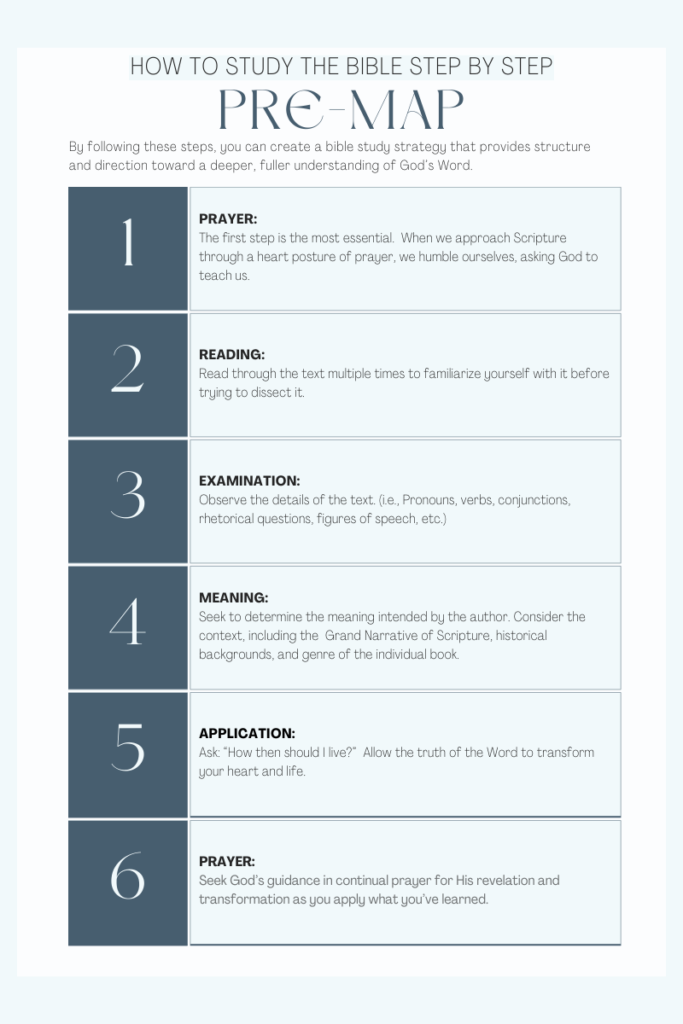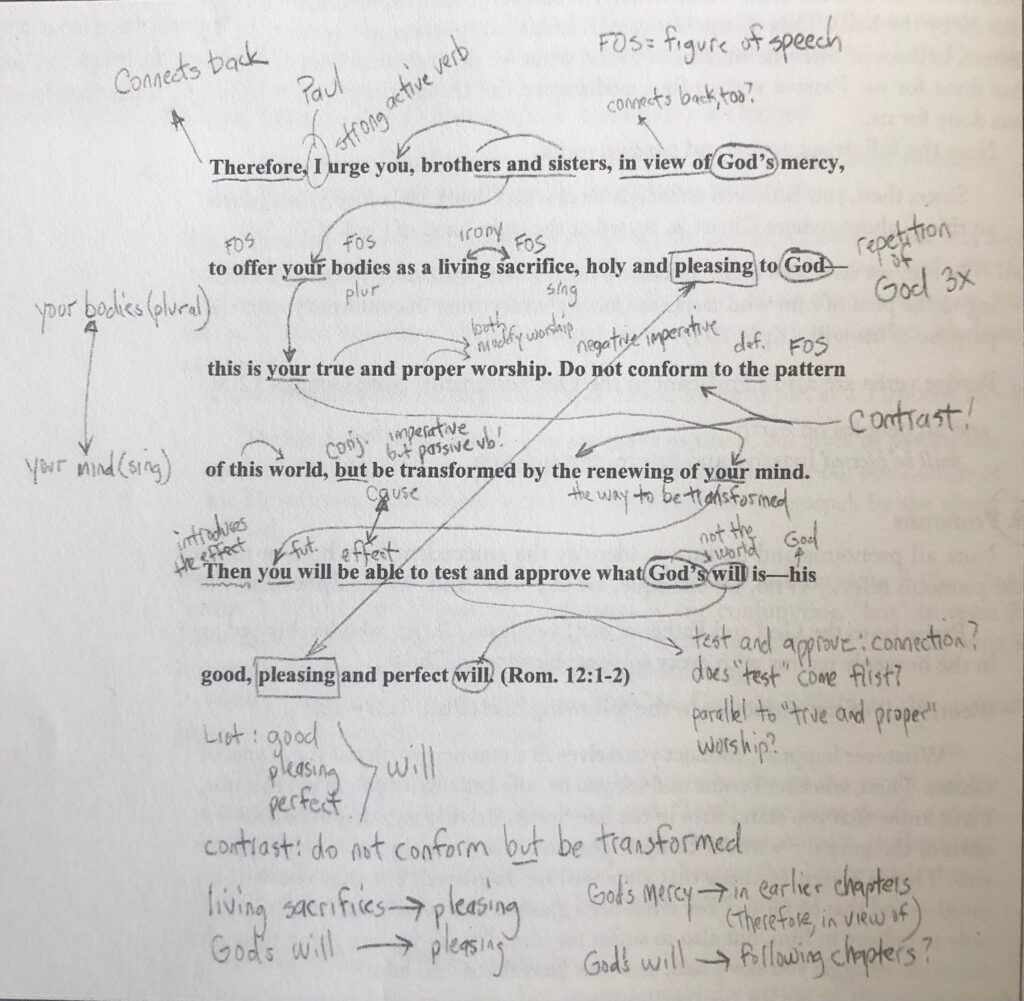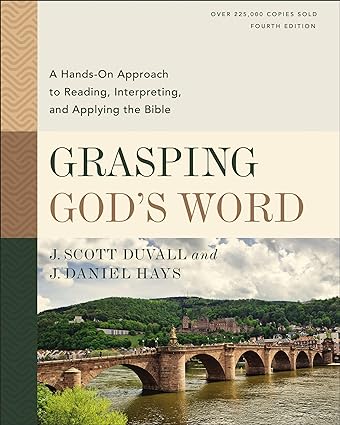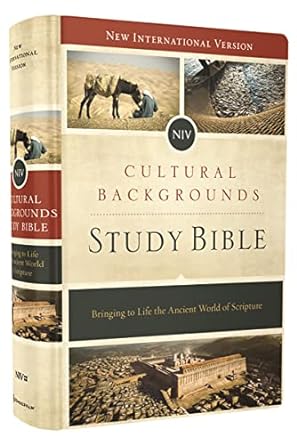Bible Study 101: A Step-By-Step Approach

So Philip ran to him and heard him reading Isaiah the prophet and asked, ‘Do you understand what you are reading?’ And he said, ‘How can I, unless someone guides me?’
Acts 8:30-31, ESV
Have you ever traveled to a foreign country without a plan or itinerary?
Years ago, I flew to Rome on a budget with very little planning. The ruins of the Roman Forum, however, won a spot on my itinerary list. The sheer antiquity of the stones alone evoked awe and imagination, but without context, I had no clue what I was looking at. Had I splurged for a knowledgeable tour guide, the stories behind those rocks would have enriched my experience a thousand times. It’s one thing to marvel at the Roman Forum; it’s another level to understand why it’s there in the first place.
I think we tend to read the Bible the way I set off to explore Rome. The whimsy of wandering wherever our spirits lead feels exciting and romantic, and we’re sure to experience amazing moments that make the trip worthwhile. But what if there is more than meets the eye? In the same way that a guide could have brought the ruins to life for me, I believe a map to guide our Bible study transforms the way we see Scripture. Without it, we miss essential details to interpret our observations and deepen our awe of God.
BIBLE STUDY ROADMAP
Many worldwide sectors, such as urban planning, environmental agencies, and engineering, use preliminary maps as a basic outline to guide further development. In the same way, a preliminary map for Bible study can serve as the framework for approaching and interpreting Scripture. It provides structure and direction as we aim for a deeper, fuller understanding of God’s Word.
Various Bible study methods exist, and it’s important to find the one that works best for you. Here, I’ve combined aspects of different approaches using the concept of a preliminary map (PRE-MAP) to guide us on our journey.

PRAYER
I have spoken these things to you while I remain with you. But the Counselor, the Holy Spirit, whom the Father will send in my name, will teach you all things, and remind you of everything I have told you.
John 14:25-26, CSB
Prayer is essential to Bible study. Without the Holy Spirit’s illumination, we risk observation without revelation and knowledge without transformation. But when we approach Scripture through a heart posture of prayer, we humble ourselves, asking God to teach us. The Holy Spirit is our guide, helping us discover what we might not see for ourselves, convicting and shaping us as we seek God through His Word.
Remember that the purpose of Bible study is not to collect information about God but to know Him intimately. Prayer is the vehicle that will take us further on this journey than we’d ever go alone.
READING
Do your best to present yourself to God as one approved, a worker who has no need to be ashamed, rightly handling the word of truth.
2 Timothy 2:15, ESV
Getting a sense of the land before mining for gold is essential. It’s the same with Bible study. In a previous post, I described three crucial keys to approaching the Bible. Whether we aim to study one of the Gospels or a prophetic book of the Old Testament, we always need to consider its message within the larger story of the Bible, its historical context and circumstances, and the literary genre in which it was written. Understanding the context brings Scripture to life, much like the stories behind the Roman Forum stones.
Before digging deeper, we need to understand the overall purpose of the book. Reading through it gives us a sense of the author’s intention, recurring themes, and key concerns. Without establishing the big picture within the text, we risk misinterpreting or misapplying our observations.
At this point, however, our primary goal is to familiarize ourselves with the text. We are not seeking to dissect anything yet; we simply want to get acquainted with God’s Word.
Enjoy it. Absorb it. Then, read it again.
Repetition is the key to internalizing the Word of God and the starting point for fuller comprehension and examination in the next step.
EXAMINATION:
Open my eyes, that I may behold wondrous things out of your law.
Psalm 119:8
Most study methods refer to this step as observation. Bible teacher Jen Wilkin prefers the term comprehension since it conveys the objective goal of understanding what the author intended versus what merely stands out to us.1 But interpretation is not yet our goal. We first want to focus on what the text says, not what it means.
After reading the text, we begin again, noticing the sentence details. I prefer to annotate my findings using a pencil and highlighters. I circle words, draw lines to related concepts, and take notes. It’s okay to write in your Bible!
Journal Bibles often include wider margins for notetaking, but you may also find it helpful to print an online copy of the chapter and keep it in a separate notebook as you work through a passage.2
WHAT TO LOOK FOR:

While these observational considerations are not exhaustive, they will provide a great starting point.
- Notice and highlight repeated words or phrases. These are often keywords indicating important themes the author wants to convey.
First John 1-5 is a great example. We can immediately observe keywords such as light, truth, abide, and love recurring throughout the book. I’ve provided an example in Figure 2. What other repeated words or concepts do you see?
- Observe conjunctions (e.g., but, therefore, so that, and, if, etc.) that connect part of a sentence to a related thought.
We know that “but” suggests a contrast between two thoughts, while “if” indicates a condition. You may have also heard that when you see the word “therefore,” you must ask yourself, “What’s it there for?” Whatever proceeds must be considered in light of what preceded it, and sometimes, we may have to go back to previous chapters to discover the connection.

Understanding the associations between words will better equip us to interpret our findings. I usually circle these, draw an arrow to the connected point, or note the related chapter in the margins. (See Figure 3).
- Take note of the pronouns and verbs the author uses. Pay attention to lists, figures of speech, cause-and-effect relationships, or rhetorical questions.
Who is the pronoun referring to? Is the verb active or passive? Not only do we need to understand who the author is addressing, but the use of an active or passive verb will help us understand if it is something we do or what God has already done.3 Recognizing these and other literary techniques will help us form a more accurate interpretation.
MEANING:
Then he opened their minds to understand the Scriptures.
Luke 24:45, ESV
The Bible cannot mean something to us that it never could have meant to the original audience.4 This is why these steps are so important. I’ve been in many bible study groups where the leader asks, “What does this mean to you?” As a young Christian, I’m sure I was guilty of that myself. However, this is the wrong question to ask. Our goal is not to create meaning but to discover the meaning intended by the author.5 Only then can we properly apply the Scriptures to our lives.
As we seek the Holy Spirit’s guidance in determining the meaning, we must remember that any so-called revelation or “new” interpretation derived from the text should be questioned. In Grasping God’s Word, the authors make a crucial point:
Because of the Spirit’s work of inspiration and illumination, we know that the Spirit and the Word work together and must never be set against one another. Since the Spirit inspired Scripture in the first place, we should not expect him to contradict himself when he illuminates it. This means, for example, that we should not allow personal experience, religious tradition, or community consensus to stand above the Spirit-inspired Word of God. The Spirit does not add new meaning to the biblical text; instead, he helps believers understand and apply the meaning that is already there….6
We will also misinterpret the meaning of Scripture if we immediately jump from reading to application. Only after we grasp the author’s intent and how it fits into the Bible’s overarching story will we discern the theological principle that transcends culture and time despite vast differences between the author’s audience and us.
Many great resources also help us understand and wrestle through challenging passages. The cross-references in the margins of our Bibles can be helpful. They connect the dots throughout Scripture, linking particular verses and themes. I also recommend having a good Bible commentary but use it after you’ve done your own work. This way, you can discern whether it’s a trustworthy source and decide whether or not you agree with its conclusion based on your observations and study.
APPLICATION:
All Scripture is breathed out by God and profitable for teaching, for reproof, for correction, and for training in righteousness, that the man of God may be complete, equipped for every good work.
2 Timothy 3:16-17, ESV
Now that we have determined what the passage says and means, we are ready to apply it to our lives. Knowing and understanding what the Bible says is no good unless we allow it to transform us.
For if anyone is a hearer of the word and not a doer, he is like a man who looks intently at his natural face in a mirror. For he looks at himself and goes away and at once forgets what he was like. But the one who looks into the perfect law, the law of liberty, and perseveres, being no hearer who forgets but a doer who acts, he will be blessed in his doing. (James 1:23-25, ESV)
Taking what we have learned about God and people from our studies, we can ask ourselves, “How then should I live?” Remember, if the principle was true for the original audience, it remains true for us today. But we cannot change ourselves by our own strength. We need God’s empowering grace. As a result, we should always conclude our study the same way we began: prayer.
PRAYER:
For the word of God is living and active, sharper than any two-edged sword, piercing to the division of soul and of spirit, of joints and of marrow, and discerning the thoughts and intentions of the heart.
Hebrews 4:12
As we seek to interpret and apply the Scriptures, we’ll find that they are interpreting and changing us.7 Any sincere student of the Bible will be convicted and transformed by the Word of God. We should bring the truths we learn, our questions, and our struggles to the Lord in prayer. It’s the ongoing communication we experience with God throughout our study time. He alone helps us understand and change to become more like Him.
So, pray…confess, repent, request, praise, and give thanks for all He shows you. And be patient with yourself. We will only ever scratch the surface of the depths of His wisdom and truth, but the Word is alive and active, always accomplishing what it was sent to do.8 The point of study is not about gaining more knowledge; it’s about pursuing God Himself.9
I encourage you to use this roadmap (PRE-MAP) in your next Bible study and see how God deepens your understanding and draws you closer to Him. Just as knowing the stories behind the Roman Forum transformed my appreciation, studying God’s Word will bring it to life in fresh and meaningful ways.
May the Lord use your study time to illuminate His truth and transform your life.
Happy studying!
FOR FURTHER STUDY AND READING:
- Jen Wilkin, Women of the Word: How to Study the Bible with Both Our Hearts and Our Minds (Wheaton, IL: Crossway, 2014), 97. ↩︎
- Free online resources like Biblehub.com or Biblegateway.com will allow you to print any chapter or passage. ↩︎
- Scott Duvall and J. Daniel Hays, Grasping God’s Word: A Hands-On Approach to Reading, Interpreting, and Applying the Bible, 3rd ed. (Grand Rapids, MI: Zondervan, 2012), 61. ↩︎
- Gordon D. Fee and Douglas Stuart, How to Read the Bible for All Its Worth (Grand Rapids: Zondervan, 2014), 34. ↩︎
- Duvall and Hays, Grasping God’s Word, 195. ↩︎
- Duvall, 226. ↩︎
- Duvall, 230. ↩︎
- See Isaiah 55:11. ↩︎
- Wilkin, Women of the Word, 111. ↩︎







